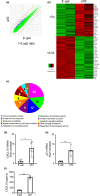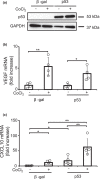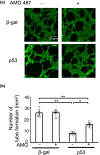CXCL10 is a novel anti-angiogenic factor downstream of p53 in cardiomyocytes
- PMID: 35542987
- PMCID: PMC9091994
- DOI: 10.14814/phy2.15304
CXCL10 is a novel anti-angiogenic factor downstream of p53 in cardiomyocytes
Abstract
Tumor suppressor protein p53 plays crucial roles in the onset of heart failure. p53 activation results in cardiac dysfunction, at least partially by suppressing angiogenesis. Though p53 has been reported to reduce VEGF production by inhibiting hypoxia-inducible factor, the anti-angiogenic property of p53 remains to be fully elucidated in cardiomyocytes. To explore the molecular signals downstream of p53 that regulate vascular function, especially under normoxic conditions, DNA microarray was performed using p53-overexpressing rat neonatal cardiomyocytes. Among genes induced by more than 2-fold, we focused on CXCL10, an anti-angiogenic chemokine. Real-time PCR revealed that p53 upregulated the CXCL10 expression as well as p21, a well-known downstream target of p53. Since p53 is known to be activated by doxorubicin (Doxo), we examined the effects of Doxo on the expression of CXCL10 and found that Doxo enhanced the CXCL10 expression, accompanied by p53 induction. Importantly, Doxo-induced CXCL10 was abrogated by siRNA knockdown of p53, indicating that p53 activation is necessary for Doxo-induced CXCL10. Next, we examined the effect of hypoxic condition on p53-mediated induction of CXCL10. Interestingly, CXCL10 was induced by hypoxia and its induction was potentiated by the overexpression of p53. Finally, the conditioned media from cultured cardiomyocytes expressing p53 decreased the tube formation of endothelial cells compared with control, analyzed by angiogenesis assay. However, the inhibition of CXCR3, the receptor of CXCL10, restored the tube formation. These data indicate that CXCL10 is a novel anti-angiogenic factor downstream of p53 in cardiomyocytes and could contribute to the suppression of vascular function by p53.
Keywords: CXCL10; angiogenesis; cardiomyocyte; hypoxia; p53.
© 2022 The Authors. Physiological Reports published by Wiley Periodicals LLC on behalf of The Physiological Society and the American Physiological Society.
Figures




Similar articles
-
The role of hypoxia and p53 in the regulation of angiogenesis in bladder cancer.J Urol. 2001 Jun;165(6 Pt 1):2075-81. doi: 10.1097/00005392-200106000-00073. J Urol. 2001. PMID: 11371931
-
The cardiac maladaptive ATF3-dependent cross-talk between cardiomyocytes and macrophages is mediated by the IFNγ-CXCL10-CXCR3 axis.Int J Cardiol. 2017 Feb 1;228:394-400. doi: 10.1016/j.ijcard.2016.11.159. Epub 2016 Nov 10. Int J Cardiol. 2017. PMID: 27870968
-
Cancer therapy modulates VEGF signaling and viability in adult rat cardiac microvascular endothelial cells and cardiomyocytes.J Mol Cell Cardiol. 2012 May;52(5):1164-75. doi: 10.1016/j.yjmcc.2012.01.022. Epub 2012 Feb 3. J Mol Cell Cardiol. 2012. PMID: 22326847
-
Metformin improves the angiogenic potential of human CD34⁺ cells co-incident with downregulating CXCL10 and TIMP1 gene expression and increasing VEGFA under hyperglycemia and hypoxia within a therapeutic window for myocardial infarction.Cardiovasc Diabetol. 2016 Feb 9;15:27. doi: 10.1186/s12933-016-0344-2. Cardiovasc Diabetol. 2016. PMID: 26861446 Free PMC article.
-
Hypoxia/ischemia promotes CXCL10 expression in cardiac microvascular endothelial cells by NFkB activation.Cytokine. 2016 May;81:63-70. doi: 10.1016/j.cyto.2016.02.007. Epub 2016 Feb 15. Cytokine. 2016. PMID: 26891076
Cited by
-
Oncostatin M Reduces Pathological Neovascularization in the Retina Through Müller Cell Activation.Invest Ophthalmol Vis Sci. 2024 Jan 2;65(1):22. doi: 10.1167/iovs.65.1.22. Invest Ophthalmol Vis Sci. 2024. PMID: 38190125 Free PMC article.
-
Bioinformatics analysis and experimental validation of the potential relationship between bacterial lipopolysaccharide and oral squamous cell carcinoma.PLoS One. 2025 Aug 21;20(8):e0329231. doi: 10.1371/journal.pone.0329231. eCollection 2025. PLoS One. 2025. PMID: 40839565 Free PMC article.
References
-
- Altara, R. , Manca, M. , Hessel, M. H. , Gu, Y. , Vark, L. C. , Akkerhuis, K. M. , Staessen, J. A. , Struijker‐Boudier, H. A. J. , Booz, G. W. , & Blankesteijn, W. M. (2016). CXCL10 is a circulating inflammatory marker in patienyts with advanced heart failure: Pilot study. Journal of Cardiovascular Translational Research, 9(4), 302–314. 10.1007/s12265-016-9703-3 - DOI - PubMed
-
- Altara, R. , Manca, M. , Hessel, M. H. , Gu, Y. , Vark, L. C. , Akkerhuis, K. M. , Staessen, J. A. , Struijker‐Boudier, H. A. J. , Booz, G. W. , & Blankesteijn, W. M. (2016). CXCL10 is a circulating inflammatory marker in patients with advanced heart failure: A pilot study. Journal of Cardiovascular Translational Research, 9, 302–314. 10.1007/s12265-016-9703-3 - DOI - PubMed
-
- Gogiraju, R. , Xu, X. , Bochenek, M. L. , Steinbrecher, L. S. E. , Wenzel, P. , Kessel, M. , Zeisberg, E. M. , Dobbelstein, M. , & Schäfer, K. (2015). Endothelial p53 deletion improves angiogenesis and prevents cardiac fibrosis and heart failure induced by pressure overload in mice. Journal of the American Heart Association, 4, e001770. 10.1161/JAHA.115.001770 - DOI - PMC - PubMed
Publication types
MeSH terms
Substances
LinkOut - more resources
Full Text Sources
Molecular Biology Databases
Research Materials
Miscellaneous

